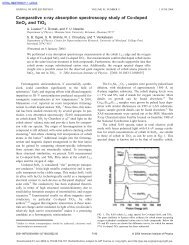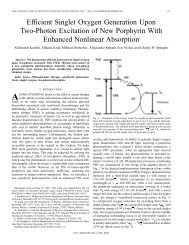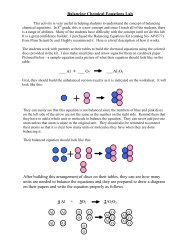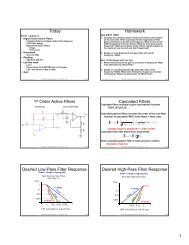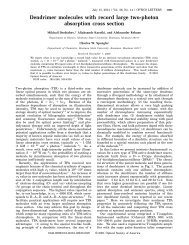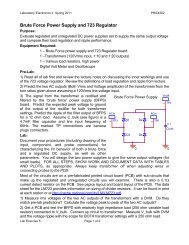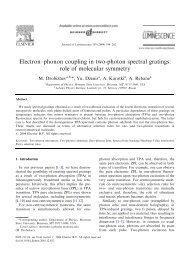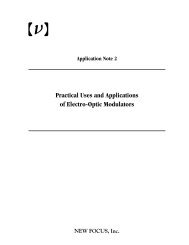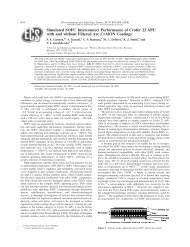Defects in inorganic photorefractive materials and their investigations
Defects in inorganic photorefractive materials and their investigations
Defects in inorganic photorefractive materials and their investigations
Create successful ePaper yourself
Turn your PDF publications into a flip-book with our unique Google optimized e-Paper software.
6 B. Briat et al.<br />
break<strong>in</strong>g <strong>their</strong> equivalence. Also such bound polarons lead to strong optical<br />
absorptions [7, 11], due to the long transition dipole between the <strong>in</strong>itial <strong>and</strong><br />
a neighbor<strong>in</strong>g oxygen ion <strong>in</strong> the tetrahedron. For more details, see Section 6.<br />
Some of the <strong>photorefractive</strong> crystals, such as congruently melt<strong>in</strong>g LiNbO 3<br />
(LN), Sr 1−x Ba x Nb 2 O 6 (SBN)orBa 1−x Ca x TiO 3 (BCT), are strongly disordered.<br />
This leads to considerable spatial fluctuations of the defect levels,<br />
caus<strong>in</strong>g wide l<strong>in</strong>es <strong>in</strong> all spectroscopic studies [12]. Furthermore, the mobility<br />
of quasifree charge carriers tends to be reduced <strong>in</strong> such <strong>materials</strong>.<br />
3 Methods of defect <strong>in</strong>vestigation<br />
We start by giv<strong>in</strong>g a qualitative overview of the electron paramagnetic resonance<br />
(EPR) method. The electronic ground state of a paramagnetic defect<br />
is characterized by its spatial distribution <strong>and</strong> by its sp<strong>in</strong> number. With<strong>in</strong><br />
the spatial range of <strong>their</strong> wavefunction, the unpaired electrons collect all <strong>in</strong>teractions<br />
by which they can couple with <strong>their</strong> surround<strong>in</strong>gs, among these:<br />
sp<strong>in</strong>-sp<strong>in</strong>- <strong>and</strong> sp<strong>in</strong>-orbit-coupl<strong>in</strong>g, also <strong>in</strong> comb<strong>in</strong>ation with crystal fields, <strong>and</strong><br />
hyperf<strong>in</strong>e <strong>in</strong>teraction of the electrons with the ’visited’ nuclei, represent<strong>in</strong>g local<br />
probes <strong>in</strong> the crystal. If a static external magnetic field is applied, Zeeman<br />
<strong>in</strong>teraction is also active. EPR methods probe the energy splitt<strong>in</strong>gs between<br />
the lowest states caused by these coupl<strong>in</strong>gs. The external magnetic field provides<br />
a reference direction <strong>and</strong> thus allows the symmetry of the <strong>in</strong>teractions<br />
to be identified. They are of tensorial character if the defect as a whole or<br />
the positions of the <strong>in</strong>teract<strong>in</strong>g nuclei are non-cubic. This analysis leads to<br />
the most essential <strong>in</strong>formation supplied by the method: the symmetry of the<br />
coupl<strong>in</strong>g tensors <strong>and</strong> the orientation of <strong>their</strong> pr<strong>in</strong>cipal axes with respect to the<br />
crystal lattice, strongly narrow<strong>in</strong>g down possible defect models. For a recent<br />
overview on the application of EPR <strong>and</strong> related techniques, especially optical<br />
ones, to the elucidation of defect properties see, e.g., Ref. [13].<br />
It is an advantage of the EPR method that it allows to determ<strong>in</strong>e the concentration<br />
of paramagnetic defects [14], open<strong>in</strong>g the way to the quantitative<br />
analysis of the performance of a <strong>photorefractive</strong> material on the basis of EPR<br />
studies alone. For further details see Section 5. EPR can ’count’ defect densities<br />
down to a few ppm. Only neutron activation analysis, see for example [15]<br />
is more sensitive. But there it is not possible to detect <strong>in</strong>tr<strong>in</strong>sic defects or to<br />
differentiate between the various charge states which the same defect element<br />
can assume, such as e.g. Fe 3+ <strong>and</strong> Fe 5+ , a task which can be solved by EPR.<br />
All <strong>in</strong>teractions probed by the electron(s) are usually summarized by a<br />
sp<strong>in</strong>-Hamiltonian, for example:<br />
H = µ B BgS + SDS + ∑ SA i I i + ..... (1)<br />
where only three representative terms are given for illustration. The first one<br />
describes the Zeeman <strong>in</strong>teraction, the second a crystal field <strong>in</strong>teraction <strong>and</strong>





